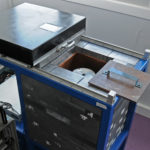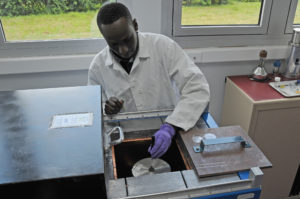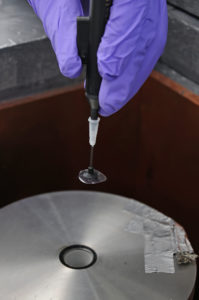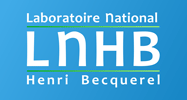Well-type detector

The 4πγ-counting technique is widely used in the field of radioactivity metrology since the 1960s and recognized as a powerful primary method for the standardization of radionuclides decaying with abundant gamma emissions [1, 2].
 The method is based on the use of gamma-ray detectors with almost 4π geometry, e.g. a large well-type NaI(Tl) detector or two NaI(Tl) detectors sandwiching the radioactive source. Due to the summing properties of such a detector, the method have turned out to be very powerful instruments, particularly for the metrology of gamma-radiation emitting radionuclides with complex decay schemes incorporating coincident photon transitions. For a few coincident gamma rays, the efficiency approaches nearly 100% and the uncertainty becomes very small (close to 0.1%) and generally independent of a knowledge of the precise values of the decay-scheme parameters. In such cases, the 4πγ technique represents a less complicated alternative to 4πβ-γ coincidence counting with similar or even better standard uncertainties.
The method is based on the use of gamma-ray detectors with almost 4π geometry, e.g. a large well-type NaI(Tl) detector or two NaI(Tl) detectors sandwiching the radioactive source. Due to the summing properties of such a detector, the method have turned out to be very powerful instruments, particularly for the metrology of gamma-radiation emitting radionuclides with complex decay schemes incorporating coincident photon transitions. For a few coincident gamma rays, the efficiency approaches nearly 100% and the uncertainty becomes very small (close to 0.1%) and generally independent of a knowledge of the precise values of the decay-scheme parameters. In such cases, the 4πγ technique represents a less complicated alternative to 4πβ-γ coincidence counting with similar or even better standard uncertainties.
Therefore, the 4πγ-counting method is used at the LNHB for the measurement of any gamma-emitting radionuclide with a decay scheme presenting coincident photon transitions, mainly for international comparisons for the SIR (International Reference System for gamma-emitting radionuclides), EURAMET, CCRI, or for calibrations.
 The dedicated instrumentation employed at the LNHB has the following geometry characteristics: 152 mm diameter and 127 mm cylinder height with a coaxial re-entrant hole of 21 mm diameter and 47.5 mm height. The scintillation detector (coupled with a photomultiplier tube) is housed in a shielding composed of an internal 1-cm-thick layer of Copper and an external 15-cm-thick layer of Lead in order to reduce the background rate (of about 16-20 s-1). The counting system is based on separate NIM modules, with a homemade discriminator module (MTR2) based on extendable dead-times and the live-time technique. The activity is then obtained from the response of the detector (the mean count rate corrected for dead time effects and background) and the detection efficiency specific to each radionuclide (obtained by means of Monte Carlo calculation) [3].
The dedicated instrumentation employed at the LNHB has the following geometry characteristics: 152 mm diameter and 127 mm cylinder height with a coaxial re-entrant hole of 21 mm diameter and 47.5 mm height. The scintillation detector (coupled with a photomultiplier tube) is housed in a shielding composed of an internal 1-cm-thick layer of Copper and an external 15-cm-thick layer of Lead in order to reduce the background rate (of about 16-20 s-1). The counting system is based on separate NIM modules, with a homemade discriminator module (MTR2) based on extendable dead-times and the live-time technique. The activity is then obtained from the response of the detector (the mean count rate corrected for dead time effects and background) and the detection efficiency specific to each radionuclide (obtained by means of Monte Carlo calculation) [3].
The measurement limits is from few tens of Bq to few hundreds of kBq, with standard uncertainties in the range of 0.1% to 0.5% for high-efficiency radionuclides such as 133Ba, 192Ir or 207Bi.
Non-exhaustive list of radionuclides measured at LNHB by 4πγ method: 18F, 22Na, 24Na, 46Sc, 56Mn, 56Co, 60Co, 67Cu, 67Ga, 75Se, 87mSr, 88Y, 110mAg, 111In, 124Sb, 133Ba, 134Cs, 139Ce, 152Eu, 154Eu, 166mHo, 169Yb, 176Lu, 192Ir 203Hg, 207Bi, etc.
REFERENCES:
[1] Ballaux C. 1983 High-efficiency gamma-ray detection systems for radionuclides metrology Int. J. Appl. Isot. 34 493–9.
[2] Winkler G. and Pavlik A. 1983 Some aspects of activity measurements with NaI(Tl) well-type detectors J. Appl. Radiat. Isot. 34 547–53.
[3] Thiam C., Bobin C., Maringer F.J., Peyres V., Pommé S. 2015 Assessment of the uncertainty budget associated with 4πγ counting. Metrologia 52 S97–S107.
Our job: metrology
dosimetry
Implemented methods for the establishment of national references must be adapted to the radiation type and its intensity. They are based on measurement technics such as calorimetry, ionometry and chemical dosimetry.
Radioactivity
The variety of the emitted radiation and physical forms of the sources oblige to adapt the measurement process in order to establish national references: methods with defined geometries, or 4 π countings geometries, coincidence countings, etc.
